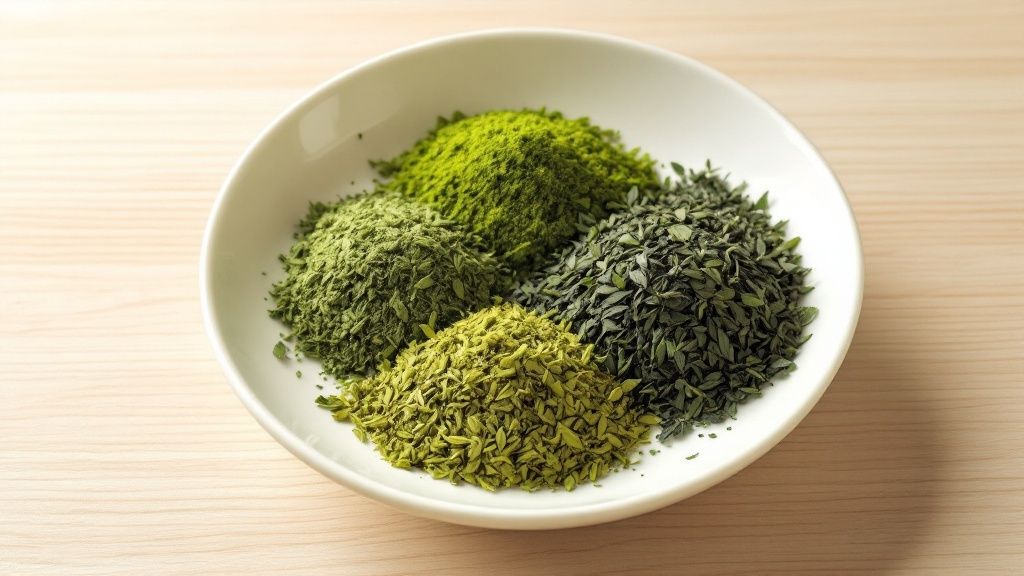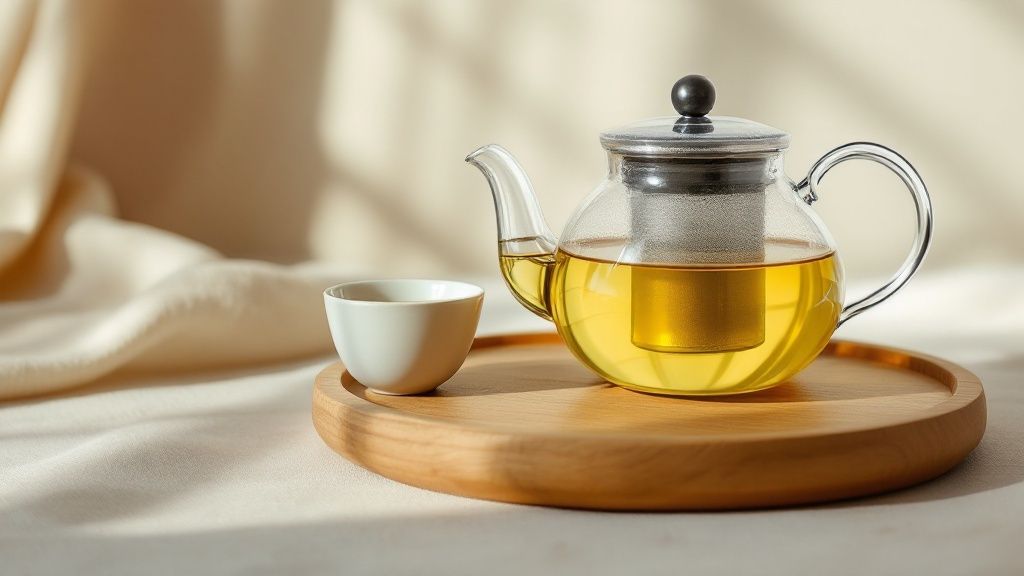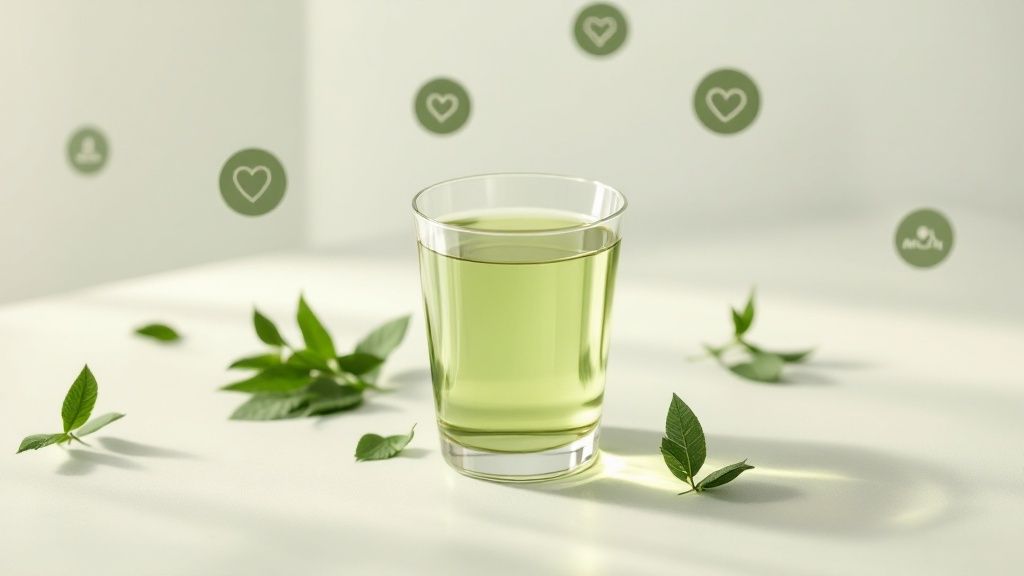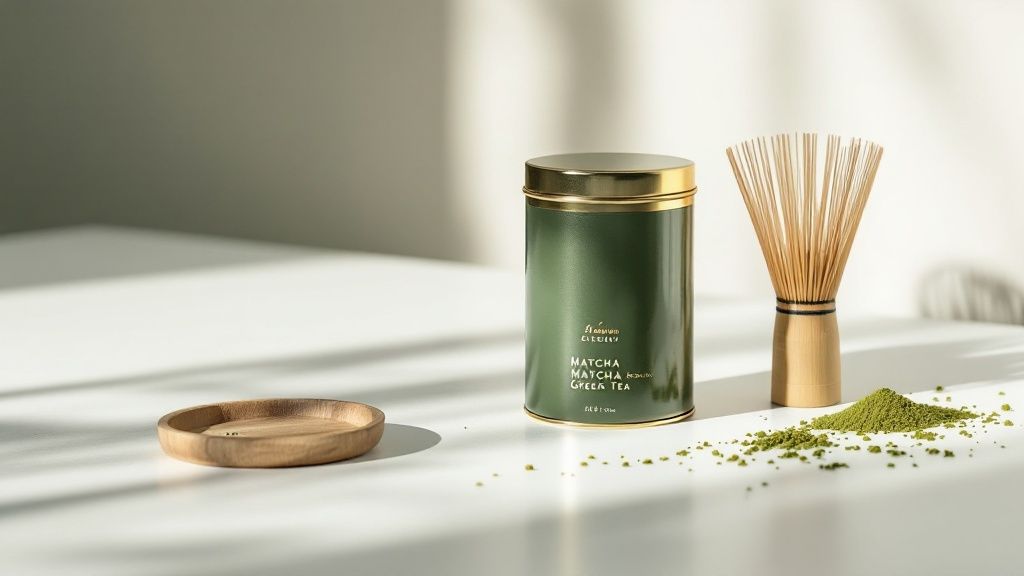Let’s be honest, trying to crown one single ‘best’ green tea is a fool's errand. The real question is, what's the best green tea for you? It all comes down to what you're looking for in a brew—whether that’s a specific flavour, a particular health benefit, or a certain level of get-up-and-go.
For a quick steer, if you want a powerful antioxidant kick and a serious energy lift, Matcha is your go-to. If you’re after a classic, balanced cuppa for any time of day, Sencha is a brilliant choice. And for something smooth and mellow to help you unwind, you can’t go wrong with a Dragon Well.
Your Guide to Finding the Best Green Tea

Diving into the world of green tea is like opening a door to an incredible spectrum of flavours. You'll find everything from fresh, grassy and savoury notes to wonderfully nutty and sweet profiles. Finding your perfect match is a personal journey, but getting to know the main players is the first step.
This guide will walk you through some of the UK's most loved varieties, helping you figure out which one belongs in your teapot.
And it seems more and more of us are on this journey. Green tea is the fastest-growing part of the UK tea market, which was valued at around £29.5 million back in 2020. That number tells a story: our tastes are changing. You can dig deeper into the UK tea market trends to see just how much green tea is shaking things up. This surge in popularity is great news for all of us, as it means there’s a wider selection of high-quality teas available than ever before.
To get you started, let's take a look at the top contenders.
Green Tea at a Glance Quick Comparison
This little table gives you a snapshot of the most popular green teas, making it easy to see how they stack up against one another at a glance.
| Tea Variety | Primary Flavour Profile | Caffeine Level | Best For |
|---|---|---|---|
| Matcha | Rich, creamy, intense umami | High | A morning energy lift or pre-workout boost |
| Sencha | Grassy, slightly sweet, marine notes | Medium | An everyday, all-purpose refreshing drink |
| Dragon Well | Toasted chestnut, mellow, smooth | Low-Medium | A relaxing afternoon or evening brew |
| Gunpowder | Bold, smoky, slightly peppery | Medium | Drinkers who enjoy a strong, robust flavour |
As you can see, each tea offers something completely different.
Each variety offers a unique experience, not just in flavour but also in preparation and cultural significance. Understanding these differences is key to finding the green tea you'll truly enjoy.
This quick introduction sets the scene for a closer look at what makes each of these teas special, from how they're grown and processed to their distinct health benefits.
Exploring the World of Green Tea Varieties

Before you can find your perfect green tea, it helps to understand what makes each type so wonderfully different. The journey from a fresh leaf on the Camellia sinensis plant to the brew in your cup is a story of place, tradition, and incredible craftsmanship. It’s this process that creates such a huge spectrum of flavours.
The most crucial difference in how green teas are made comes down to one step: stopping oxidation. This is the natural process that would otherwise turn the leaves into black tea. How a tea maker chooses to halt it defines the entire character of the final tea.
Chinese Pan-Firing Versus Japanese Steaming
In China, where it all began, the traditional method is pan-firing. The leaves are gently tossed in enormous, hot woks to stop the enzymes from browning them. This technique brings out a warmer, toastier character, often creating mellow, nutty, or subtly sweet flavours. The result is a smooth, comforting brew that feels both gentle and complex.
Over in Japan, tea masters prefer steaming. Freshly picked leaves get a quick blast of hot steam, a method they’ve perfected over centuries. This flash of heat locks in the vibrant green colour and preserves more of the fresh, vegetal notes. What you get is a completely different profile: brighter, more savoury, and with those signature grassy or marine notes, a bit like seaweed.
The choice between a pan-fired or steamed green tea is the first big fork in the road on your flavour journey. One path leads to warm, roasted notes, while the other offers crisp, oceanic vibrancy. Neither is better; they are simply different expressions of the same leaf.
This fundamental difference is why a Chinese Dragon Well tastes nothing like a Japanese Sencha, even though they’re both premium green teas. For a wider look at how this fits into the world of tea, you can explore the different types of tea and their processing methods.
Iconic Varieties and Their Stories
Once you grasp this core distinction, you can really start to appreciate the unique personality of each tea. Every single one has a story, shaped by its home and the people who crafted it.
- Sencha: The absolute classic Japanese green tea. It’s steamed, rolled, and dried to create that signature Japanese flavour—fresh, a little grassy, and with a lovely savoury hint of umami. It’s the tea you’ll find in every home in Japan, and for good reason.
- Matcha: Also from Japan, Matcha is made from special shade-grown tea leaves, which are stone-ground into a fine, electric-green powder. Because you drink the whole leaf, you get an intense, creamy flavour and a powerful dose of antioxidants.
- Dragon Well (Long Jing): A legendary pan-fired tea from Hangzhou, China. Its distinctive flat, smooth leaves brew a mellow, sweet, and nutty cup with a famously silky finish.
- Gunpowder: This Chinese tea gets its name from its appearance—the leaves are rolled into tight little pellets. When they hit hot water, they unfurl to release a bold, slightly smoky, and full-bodied flavour.
By understanding these foundations, you’re in a much better position to navigate the options and find a green tea that you’ll truly love.
A Detailed Comparison of Popular Green Teas

To really get to the heart of what makes a green tea right for you, we have to go deeper than the usual descriptions. It’s all in the subtle details—the sensory experience, the health properties, and even how it’s prepared. Each tea has its own unique personality, and understanding that is the key to finding your perfect match.
Comparing green teas is never just about the taste. It's about the entire experience, from the rich, savoury sensation known as umami to the level of bitterness, or astringency, and the wonderful aroma that rises from the cup.
Sensory Profile Showdown: Matcha vs Dragon Well
Let’s start with two giants from very different corners of the tea world: Japanese Matcha and Chinese Dragon Well (Long Jing). On paper, they’re both premium green teas. In the cup, they couldn't be more different.
A good ceremonial grade Matcha is all about its intense, creamy umami. That deep, almost brothy savouriness comes from shade-growing the tea plants, which ramps up the chlorophyll and L-theanine. The result is a thick, velvety texture with a sweet finish that lingers, and there should be practically no bitterness if you prepare it properly.
Dragon Well, on the other hand, is a much gentler, more soothing affair. Its leaves are pan-fired, which brings out a smooth, mellow character with lovely notes of toasted chestnut and a hint of buttery sweetness. It has very low astringency, making it an incredibly forgiving and relaxing brew to enjoy.
The real difference comes down to how they’re prepared and consumed. With Matcha, you whisk and drink the entire powdered leaf, giving you a bold, full-bodied experience. Dragon Well is steeped, offering a delicate, clean infusion where nuance and subtlety are everything.
So, which to choose? It’s all about what you’re in the mood for. Are you looking for a vibrant, powerful lift or a quiet, contemplative moment?
Health And Caffeine: A Look At Sencha And Gunpowder
When we talk about health benefits, the concentration of antioxidants like Epigallocatechin gallate (EGCG) is usually top of the list. While all green teas have these wonderful compounds, the levels can vary quite a bit.
Sencha, the classic everyday green tea from Japan, is a brilliant source of antioxidants. Because it's steamed and grown in full sun, it finds a fantastic balance, offering a healthy dose of EGCG alongside a moderate caffeine kick of around 20-30 mg per cup. Its flavour is crisp, grassy, and ever so slightly marine—a truly refreshing and invigorating choice.
Gunpowder tea, with its tightly rolled little pellets, brews up into something more robust and potent. This pan-fired Chinese tea often has a bit more caffeine than Sencha and a bold, smoky flavour. The rolling process is clever; it protects the leaves, preserving their potency and leading to a strong, powerful infusion.
Of course, understanding how green tea differs from black tea helps put these benefits into context. For a closer look, our guide on the distinctions between green tea vs black tea has all the details.
Detailed Green Tea Feature Analysis
To make things a bit clearer, here’s a table that breaks down the key features of these popular green teas side-by-side. It's a handy way to see exactly how they stack up against one another.
| Tea Type | Origin & Processing | Flavour Notes | Caffeine (mg per cup) | EGCG Content | Average UK Price |
|---|---|---|---|---|---|
| Matcha | Japan; Shade-grown, powdered | Creamy, deep umami, sweet finish | 60-70 | Very High | £20-£40 per 30g |
| Sencha | Japan; Steamed, sun-grown | Grassy, oceanic, slightly sweet | 20-30 | High | £8-£15 per 100g |
| Dragon Well | China; Pan-fired, flat-pressed | Toasted chestnut, mellow, buttery | 15-25 | Moderate | £12-£25 per 100g |
| Gunpowder | China; Pan-fired, rolled pellets | Bold, smoky, slightly peppery | 30-40 | Moderate-High | £5-£10 per 100g |
This table really shows how the way a tea is processed directly shapes not just its flavour, but its chemical makeup too. Matcha's unique production puts it in a class of its own for both caffeine and EGCG, making it a true powerhouse. Meanwhile, Dragon Well offers a much gentler alternative across the board. By understanding these nuances, you can pick a tea that perfectly fits your taste and what you're hoping to get from your daily cup.
Fitting Green Tea into Your Daily Rhythm

It’s one thing to know your way around flavour profiles and antioxidant counts, but the real art of enjoying green tea is knowing when to drink each type. The best brew is always the one that slots perfectly into your day, making a particular moment just that little bit better. It’s all about matching the tea’s character to what you need, whether that’s a jolt of energy, a moment of calm, or just a healthy, refreshing drink.
Take a moment to think about the rhythm of your own day. Are you looking for a clean swap for your morning coffee? Or maybe you need something gentle to help you unwind after a long day at the office. Each scenario really does call for a different cup of tea.
For Your Morning Jump-Start
If you need to hit the ground running, Matcha is the undisputed champion. It delivers a potent combination of high caffeine and L-theanine, which creates a uniquely calm, focused energy. You get the lift you need, but without the jittery crash that coffee can sometimes bring on. It's an ideal choice for a productive morning or even as a pre-workout boost.
There's also something wonderfully mindful about the ritual of whisking matcha. It’s a moment of focus that sets a deliberate, positive tone for the rest of your day.
For a Quiet Afternoon Pause
When the afternoon lull hits and you need a quiet moment to reset, a high-quality Dragon Well (Long Jing) is the perfect partner. With its low-to-moderate caffeine content and exceptionally smooth, mellow flavour, it’s designed to soothe rather than stimulate. Those toasty, nutty notes are deeply comforting and complex, encouraging you to slow down and just be.
This is a tea that asks for your full attention. Let its subtle character quiet your mind and help you find your focus again.
Choosing the right green tea is all about context. A bold Matcha might feel jarring on a quiet evening, while a delicate Dragon Well could easily get lost in the rush of a busy morning. The trick is to align the tea’s personality with the moment’s purpose.
This flexible approach to tea drinking is clearly catching on. Recent research shows that 37% of Brits aged 25-34 drink five or six different types of tea regularly. In fact, over half of this group (52%) already enjoys green tea, showing a real appreciation for its versatility. You can read more about these evolving tea trends in the UK.
For an All-Day Healthy Habit
For a reliable, everyday brew that you can return to throughout the day, Sencha strikes the perfect balance. It offers a refreshing, grassy flavour, a moderate caffeine kick for gentle alertness, and a brilliant dose of antioxidants. It’s neither too powerful nor too subtle, making it a fantastic and affordable choice for consistent sipping.
Whether you need a mid-morning pick-me-up or a healthy drink with lunch, Sencha always delivers. If you're keen to start exploring, you can discover a wonderful selection of premium green teas to suit any routine.
How to Brew the Perfect Cup of Green Tea
Even the most incredible green tea can end up tasting disappointingly bitter if you don't brew it right. Getting to those delicate, nuanced flavours isn't about complicated rituals, though. It really just comes down to two things: water temperature and steeping time. Get those right, and you’ll completely change your tea game.
The biggest mistake people make? Using boiling water. Green tea leaves have compounds called catechins, which are great for your health but also the source of that bitter, astringent taste. Water that’s too hot (anything over 85°C) yanks these compounds out too fast, creating a harsh flavour that completely smothers the tea's natural sweetness.
Using water just off the boil is the secret to a smooth, flavourful cup. It’s a simple change that stops you from 'scorching' the delicate leaves, letting their true character—be it grassy, nutty, or sweet—come through.
While good water is a must, it’s worth noting that some heavily processed types, like ultrapure water, might not be the best for drinking or brewing. You can read more about the implications of ultrapure water for drinking if you're curious. For most of us, good old filtered tap water is perfect.
Ideal Brewing Temperatures and Times
Different green teas have their own personalities and need a slightly different touch to really shine. A delicate, shade-grown Gyokuro, for example, needs a much cooler hand than a robust, rolled Gunpowder tea.
Here’s a rough guide to get you started:
- Japanese Teas (Sencha, Gyokuro): Go for a lower temperature, somewhere around 60-75°C. Keep the steep short, usually between 45-90 seconds. This is how you hang onto that fresh, umami-rich character.
- Chinese Teas (Dragon Well, Gunpowder): These are a bit more forgiving. They can handle slightly hotter water, say 75-85°C, and a longer steep of 1-3 minutes will draw out their lovely mellow, toasty notes.
As for how much tea to use, a good starting point is one teaspoon of loose leaves (about 2-3 grams) for every 200ml of water. Feel free to play around with this to find the strength you like best.
Elevating Your Brew with Teaware
Look, any teapot will do the job, but using traditional teaware can make the whole experience feel that much more special. A Japanese kyusu (a side-handled teapot) is brilliantly designed to give the leaves room to unfurl properly, which means a better infusion.
Likewise, a Chinese gaiwan (a lidded bowl) gives you fantastic control over the steeping process and is just perfect for taking a moment to appreciate the tea's aroma. You don't need these tools, of course, but they connect you more deeply to the art of making tea, turning every cup into a moment to truly savour.
So, Which Green Tea is Right for You?
Ultimately, finding the “best” green tea is a personal quest. There’s no single winner here; the perfect brew is the one that fits your taste, your routine, and what you’re looking for in a cup.
Think of it as matching the tea's unique character to your own. To help you decide, we’ve broken down our findings into a few simple recommendations.
Your Personal Green Tea Verdict
Choosing the right tea gets a lot easier when you know what you want from it. Are you after a serious health kick, a moment of calm, or just a reliable daily cuppa?
Here’s our final take based on what you might be looking for:
- For the Health-Conscious: Matcha is the clear choice. Because you consume the whole, powdered leaf, you get a concentrated dose of antioxidants and L-theanine that other teas just can't match.
- For the Flavour Explorer: If you appreciate complex, subtle notes, Dragon Well is a must-try. Its smooth, mellow character with those lovely toasty, chestnut notes is a real treat for mindful sipping.
- For the Everyday Brew: Sencha hits that sweet spot. It has a refreshing flavour, a moderate caffeine kick, and offers fantastic value, making it a dependable and healthy choice for your daily ritual.
- For the Adventurous Beginner: If you like bolder tastes, Gunpowder offers a fantastic starting point. Its robust, slightly smoky character is distinctive and makes for a really memorable introduction to green tea.
The most satisfying cup of green tea is one that aligns perfectly with your intention. Whether it’s for energy, relaxation, or health, letting your needs guide your choice is the secret to finding your favourite.
While black tea is still the nation’s favourite, a growing number of us are branching out. A 2025 study found that 13% of Brits now consider green tea their main brew, with younger generations really driving the trend. You can discover more insights about UK tea preferences in the full report.
Got Questions About Green Tea? We've Got Answers
Diving into the world of green tea can leave you with a few questions. Let's tackle some of the most common ones that crop up on the journey to the perfect brew.
Is Green Tea Really Lower in Caffeine Than Coffee?
Yes, and by quite a margin. A typical cup of green tea has just 20-40mg of caffeine, whereas the same size coffee can easily pack 95mg or more. But the real difference is how you feel. Green tea also contains an amino acid called L-theanine, which works with caffeine to create a sense of calm, focused energy—none of the jitters you might get from a strong cup of coffee.
What's the Best Way to Store My Green Tea?
Proper storage is key to keeping those delicate flavours and antioxidants intact. Think of your tea leaves as a fresh ingredient. You’ll want to keep them in an airtight container, tucked away somewhere cool, dark, and dry. And definitely keep them away from your spice rack or coffee beans, as those fragile leaves can soak up strong smells.
Is It Okay to Drink Green Tea Every Day?
Absolutely, and it's a fantastic habit to get into. Drinking green tea daily has been linked to all sorts of good things, from boosting heart health to sharpening your mind. For most people, enjoying 3-5 cups a day is a great way to reap the benefits without going overboard on caffeine.


